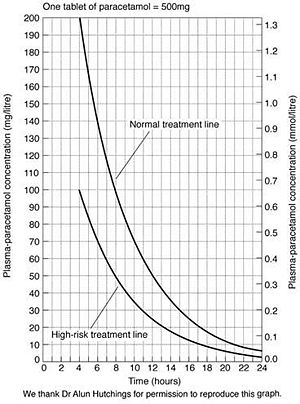Paracetamol overdose
This page is about the medical treatment of paracetamol overdose. Visit suicide if you want to find more about the mental health aspect of paracetamol overdose.
Definition
Taking more than the recommended amount of paracetamol. (2x500mg, 4 times a day with 6 hour gaps between each dose).
Epidemiology
I think the big red thing covers it. It's more common in girls because it's generally a form of parasuicide but blokes do it too.
Pathophysiology
Basically, paracetamol is metabolised by conjugation with two chemicals called sulfate and glucuronide; some is oxidised by the cytochrome P450 enzyme system. When sulfate and glucuronide run out, P450 takes over completely. The P450 system produces a substance called NAPQI which is metabolised by glutathione, found in the liver cells.
In high levels, the glutathione runs out, leaving NAPQI floating around the liver. NAPQI kills liver cells i.e. it's hepatotoxic. This is what does the damage.
(NAPQI stands for N-acetyl-p-benzoquinoneimine just in case it comes up in a pub quiz.)
Risk Factors

.
Rather than having specific risk factors for self-harm here, it's probably just best to look at the suicide page. These risk factors are medical. They are classified into high-risk or not high-risk. There are certain criteria which put them into the high-risk category:
Clinical Features
There are three things you 'definitely need to ask with any overdose are:
- What drug(s)?
- How many?
- When? (Ask specifically if they took them all at once or at different times i.e. staggered overdose)
In terms of further clinical features, they're usually asymptomatic. If they do have symptoms, nausea and vomiting are the most common and most symptoms occur 24 hours after ingestion. Other possible features, usually after apparent recovery are tender hepatomegaly, acute liver failure with encephalopathy, hypotension, hypoglycaemia and acute tubular necrosis (I don't actually know what that is).